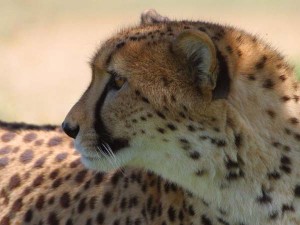 Imagine a little box of spoons. Now, imagine on moving day that that box of spoons is put into a bigger box with all of the silverware. Now, imagine that that box of silverware is placed into an even bigger box with all of the kitchen stuff.
Imagine a little box of spoons. Now, imagine on moving day that that box of spoons is put into a bigger box with all of the silverware. Now, imagine that that box of silverware is placed into an even bigger box with all of the kitchen stuff.
Now, imagine that the box of kitchen stuff is placed in the moving truck with all of the stuff from your house. In the end the within the truck is all of the stuff from your house, within kitchen box are all of the things from the kitchen, and within the spoon box are just the spoons.
In the same way, we will group organisms according to their physical appearance into hierarchical categories.
[am4show have=’p8;p9;p28;p55;’ guest_error=’Guest error message’ user_error=’User error message’ ]
In this unit we’re going to discuss invertebrates by naming what characteristics they have, and placing them in categories accordingly. For example, jellyfish are placed in the Cnidarian category due to their radial symmetry and stinging cells.
Meanwhile Cnidarians are placed in the invertebrate category due to their lack of a backbone. Furthermore, invertebrates are placed in the animal category because they are multicellular, eukaryotic (having cells containing true nuclei), and heterotrophic (required to eat molecules to survive: do not produce their own food).
In this way, we classify animals; we place them in categories according to physical characteristics (modern biology classifies organisms according to DNA similarity) they have (radial symmetry, stinging cells, and lack of backbone, for example).
As you can see, the largest box or category, “animals”, is much larger than the tiny category “jellyfish”. The number of organisms in each category gets progressively fewer as you classify things from animals in general, to jellyfish in particular. The categories follow this structure:
- Kingdom: The domain in which living organisms are classified.
- Phylum: The subdivision in which all classes below have the same body plan.
- Class: Organisms that share one or more attributes.
- Order: Containing one or more families.
- Family: Organisms descended from the same ancestors sharing relatively similar characteristics.
- Genus: Groups of species that are structurally similar or phylogenetically related.
- Species: Organisms capable of mating with one another.
An easy way to remember the order of the hierarchy is to think of this mnemonic: Kings Play Cards On Funny Green Stools—each first letter stands for the first letter of a level in the hierarchy (Kingdom, phylum, etc).
For example the classification of the jellyfish the Portuguese Man-O-War (shown):
- Kingdom: Animalia (Multicellular, heterotrophic, eukaryotic)
- Phylum: Cnidaria (Radial symmetry, stinging cells)
- Class: Hydrozoa (very small predatory animals, mostly saltwater, solitary and colonial)
- Order: Siphonophora (Colonies of specialized cells which could not survive on their own and resemble one organism)
- Family: Physaliidae (Organisms of the genus Physalia)
- Genus: Physalia (Colonies of specialized cells which float on the Indian or Pacific Oceans via gas-filled bladders)
- Species: P. physalis(Portuguese Man-O-War)
And that’s it! To get a better handle on this (it’s confusing at first!), here’s a simple activity you can do that’s fun and easy. Here’s what you need:
- Card stock
- Printer
- Ziploc bags
Here’s what you do:
- Print out the Challenge: Classifying Invertebrates file. You’ll want to print several copies the cards on card stock. You should have enough so that each team (or each student) gets a complete set of cards. They can be stored in zipper-type bags for future use.
- Work in teams to correctly classify the invertebrates. You can compare your answers to the key shown below.
- For more of a challenge, time yourselves to see which team (or student) can complete the classification fastest. One player shuffles the cards and places them in a pile, then serves at the times for the other team.
- When you’re ready for answers, print out the Answer Key.
[/am4show]


Corals are animals, even though people think they look like plants or rocks. You can read more about it here.
Is coral a living animal or is it just a plant?
And why is coral and a jellyfish in the same category?
Some animals have a layer of tissue in their eyes that reflects light which is called the tapetum lucidum. This layer of tissue allows for more light to be present in the animals’ eyes so they can see better in the dark. Most of these animals are nocturnal (they are more active at night). A downside to having a that the image the animal sees in bright light is blurry but the benefit is being able to see well in low light conditions. So when we can see the glow of an animal’s eyes we are just seeing reflected light off the tapetum lucidum. Hope this helps, here’s a link to more information:
http://en.wikipedia.org/wiki/Tapetum_lucidum
Why do some animals’ eyes seem to glow?